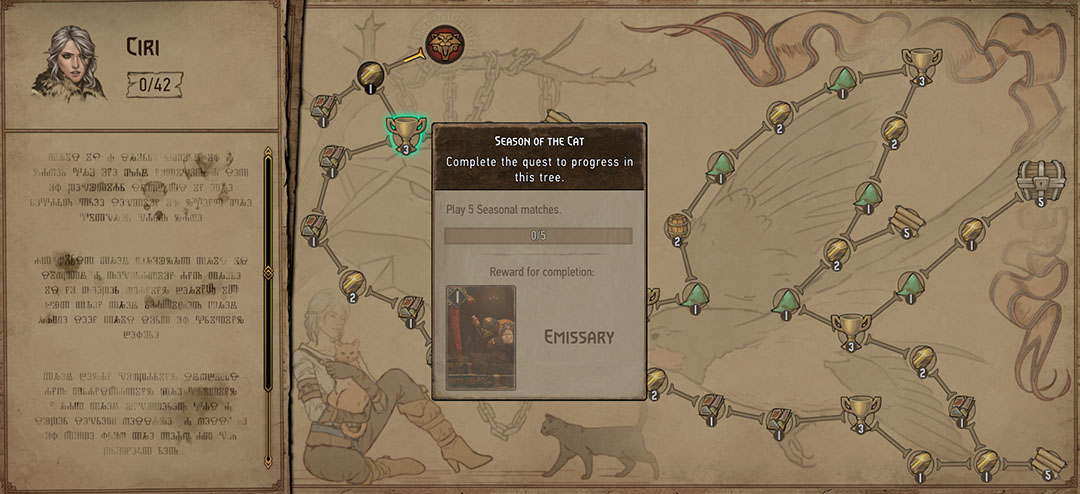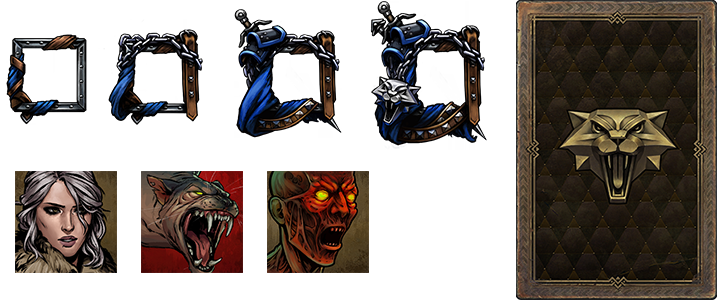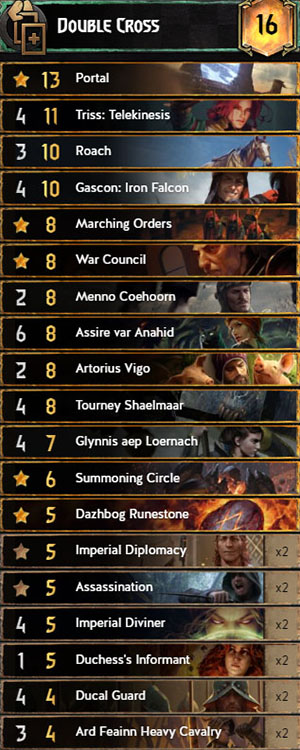
By Veruis, October 17, 2019

Hey everyone, I am Veruis, a casual player of CCG and RPG games, and I love spending my time having fun tryharding on ladder. That is why I decided to combine my strength with Team Aretuza and prepare for all of you something to help with the best mode in Gwent: Seasonal. Enjoy!

Seasonal Mode Guide: Season of the Cat
Jeśli chcesz przeczytać artykuł po polsku, kliknij tutaj.
What Is Seasonal Mode?
Seasonal Mode is a special game mode with a unique ruleset, rotating each month. You need to be at least Level 10 to join the queue.

Playing this mode allows you to complete quests in the seasonal Reward Tree. Also, this mode is the best place to complete contracts quickly. Completed contracts will grant you Reward Points (RP). While spending those, you will encounter special nodes marked with a chalice. Some of these will stop you from proceeding further until you finish a quest. A few of them can be done exclusively in seasonal mode, but most can be done in any game mode.
What if I don’t have time and Reward Points for this season’s Reward Tree?
Fear not! CDPR provides a solution: Each month, you can find a Seasonal Bundle in the store which contains everything that was available in the season four month prior with an additional bonus cosmetic on top - a new title or an avatar. Accordingly, the Seasonal Bundle of the Season of the Cat will be in the store in February 2020.
Season of the Cat

This month, you fight for the Cat card back, three unique avatars, four Cat borders, and two premium Emissaries. To complete the Season of the Cat Reward Tree, you require 85 RP, while the fastest way to the Nilfgaardian Lion border requires 49RP. To complete the Leader Tree (Ciri of Skellige), you need 84 RP, while the fastest way to the Cat cardback requires 46 RP.
I would like to point out that this season’s border is enriched version of the Cat border in Gwent's open beta.
The Rules
“After 2 turns the players switch hands.”
I must admit that CDPR nailed this Seasonal Mode. At first glance, the rules are pretty obvious and no one would imagine that such a simple rule will turn everything we know about matches in Gwent upside down.
Before we jump into cards and decks, I think that those rules requires a little explanation. “After 2 turns” means that after you and your opponent play a card and click “end turn”, your hands switch – you are getting the cards that your opponent has in hand and your opponent yours. But keep in mind that the rest of your cards in your deck and graveyard don’t switch.
So what to bring? I suggest highly synergistic cards that rely on your resources to gain the most value. Avoid point-slam, midrange and, in general, cards that can be used by your opponent. Of course, this is not always possible, especially when you are in a mirror match. But then again, just use your opponent’s cards!
As a summary of this mode, I will only add that this is probably the most difficult mode in terms of deckbuilding and gameplay. It requires a unique approach to the subject, an unprecedented mind game in Gwent, and each game is played differently, requiring planning in a way that has not been seen before.

Due to the nature of Gwent’s neutral cards, I would not encourage using them. Yes, there are strong neutrals that you can use in your deck, but you wouldn't want them to be used against you – and this is something you can hardly avoid that in this mode. For this reason, I suggest using mostly synergistic cards that are less valuable for the opponent.
- Shupe's Day Off: The great winner of this mode. It has solid value and is often useless for the opponent, so you should build most of your decks around it.
- Roach: As always, Roach can find its place in most decks, providing thinning and tempo.
- Gascon: Iron Falcon: This card works mainly in the Nilfgaard Assimilate decks, but as it can also produce win conditions for other lists, it can be used outside of Nilfgaard.
- Portal: A great tool for engines and thinning.
- Triss: Telekinesis: A good card to support your deck, but make sure to use it before your opponent can play it.

I had a lot of problems with creating an appropriate deck for Monsters in this mode; however, finally I was enlightened when I encountered a very interesting variation of Deathwish on ladder. Whoever created this deck – thank you! I made a few adjustments, so this deck fits better into Seasonal Mode, but the core remains the same.

Guide
During the mulligan, remember that holding cards such as Golyat or Yghern is not always good, because they can be used against you by your opponent. Therefore, do not hold more than one point-slam card which you should try to use immediately after the start of the match. Additionally, try to mulligan Land of a Thousand Fables and Shupe's Day Off; there will be a greater chance to draw them in Round 2. It is also important to have at least two Deathwish cards, so that Death's Shadow will not be in vain.
Depending on whether you're going first or playing reactively, you can choose a lot of different ways to make your first move. Using Miruna or Imperial Manticore to destroy the opponent’s initial engines seems like a good idea, but you can also put down Slyzard or Barbegazi as a proactive play and wait for your opponent’s next move. Sometimes all you want to do is play Golyat or Yghern to prevent your opponent from playing these cards themselves. There is no one universal rule for playing this deck. It all depends on the matchup and your opponent’s first moves.
Possible Replacements
This deck contains nothing special to exchange. You can think about swapping more expensive cards, like Yghern or Golyat, or some bronzes for others with a similar Deathwish synergy, such as Siren.

With the latest expansion, Nilfgaard received a lot of interesting support for Assimilate. This is especially noticeable in this month’s Seasonal Mode, in which, undoubtedly, Nilfgaard is the most-played faction.

Guide
The mulligan phase is not particularly difficult, as you are just looking for your most important cards: Portal, to pull out Ducal Guard or Ard Feainn Heavy Cavalry, Glynnis aep Loernach and Artorius Vigo. Unlike the other decks presented in this guide, you shouldn’t mulligan your strongest cards back into your deck because there are too many of them. In addition to the cards mentioned above, you should also try to have cards in hand that proc Assimilate, such as Dazhbog Runestone, Triss: Telekinesis or Imperial Diplomacy.
The rules of this mode dictate the plays. In rounds with “your” hand, you play cards that use the Assimilate keyword. When you have your opponent’s hand, choose cards that would give you the most value; any unit you play from your opponent’s hand will also proc Assimilate. Remember to not lose Tourney Shaelmaar to the opponent because it is worth a lot of points in this mode.
Possible Replacements
Double Cross lets us proc Assimilate, but due to the large number of Tactics this deck uses, you can also change the leader ability to Enslave. Instead of the Summoning Circle or Dazhbog Runestone, you can include Experimental Remedy as well as Bribery instead of Assire var Anahid.
Nilfgaard is the best faction to play to complete the Seasonal quest of playing 15 Witchers. You can exchange Assire var Anahid, War Council and Roach for Letho of Gulet, Serrit and Auckes.

Northern Realms isn’t looking so good this month, but they are not unplayable. It is worth to give it a chance. As this faction lacks mechanics like Deathwish for Monsters or Harmony for Scoia'tael, playing this deck requires a great deal of concentration and caution.

Guide
The best thing you can do this month is to not give your opponent the advantage of your own cards, so Shupe's Day Off is the perfect solution, especially when combined with Pincer Maneuver.
Northern Realms are generally at a disadvantage when it comes to protecting their important cards and they have no synergies that other factions cannot exploit. Therefore, you should focus on having the best possible hand to stop the opponent of interfering with your game plan. The only thing worth paying attention to is the potential mulliganing of Land of a Thousand Fables and Shupe, as this increases the chance of drawing these cards in Round 2. Additionally, you are looking for John Natalis and you can mulligan irrelevant Warfare cards, such as Mad Charge and Winch.
The plan of the game is to establish your engines, often the best, at the very beginning: Portal, Shani and Priscilla. The opponent will certainly try to disrupt your strategy by taking your most powerful cards, so every move must be thought through. Thanks to Pincer Maneuver, you have an advantage in Round 2 or 3 because you get Shupe with it.
Possible Replacements
To make the deck more consistent and increase the chances of drawing Portal, you can swap two 8-provision cards (e.g. Dandelion and Thaler) for Marching Orders and Avallac'h: Sage.

With the addition of Percival Schuttenbach and many powerful Dwarves with Iron Judgment, Scoia'tael is very good in this month’s Seasonal Mode.

Guide
This deck is largely built around Mystic Echo, including a wide range of specials and a few Harmony cards. To top it all off, you'll find Shupe's Day Off here to further weaken the deck in the hands of your opponent. All this combined makes this one of the best decks for this mode.
Before we go into battle, you need to have a plan for how you want to play the match. Cards such as Call of the Forest or Novigradian Justice can stay in your hand, unless you find yourself in a mirror match. If you draw both Percival Schuttenbach and Milva, you should mulligan one of them, because these are the cards you should start your rounds with. Water of Brokilon should be tutored with Fauve. Cleaver's Muscle and Mahakam Defender are our best targets for Novigradian Justice, so at least one of those cards has to remain in the deck. Land of a Thousand Fables is very versatile, so it is best to put it back into the deck and use it in Round 2 or 3 to pull out Shupe's Day Off. The remaining cards, mostly bronzes, are used as Harmony activators.
The game plan is simple, but it can change depending on the opponent. You start the game with Percival Schuttenbach or Milva, planning in advance which cards will be useful to proc either of the two. When you get your opponent’s hand, try your best to ruin their strategy. Water of Brokilon should be used in Round 2, but if you have it in hand, play it before Percival or Milva. In Round 2, we should go all in, using Mystic Echo and Shupe's Day Off.
Possible Replacements
The deck’s core should remain intact, so I wouldn't change the golds. When it comes to the bronzes, you have a lot of options. You can swap any card to better reflect the way you prefer to play. Consider replacing Mahakam Marauder, Dol Blathanna Archer or Panther with less useful cards like Spring Equinox, Spores or Crow's Eye – just to see how the opponent reacts when they have to use them.

On ladder, Skellige may currently be the worst faction, but when playing Seasonal Mode, I had a lot of fun commanding the islanders. Many of their skills are unique, so the opponent doesn't always have a way to use them to their full potential.

Guide
During the mulligan phase, try to draw into either Dracoturtle or Olaf. Both synergize well with self-damaging, so you should also have cards like Svalblod Priest, Raging Bear, Mardroeme, Heymaey Protector, Terror Crew Plunderer or Svalblod Butcher in hand. Additionally, it is best to mulligan Land of a Thousand Fables and Shupe's Day Off to have a better chance of using them in Round 2, the most important round.
The game itself is straightforward. In the beginning, play Svalblod Totem, Olaf or Dracoturtle and then use your self-damage cards to gain point advantage. With Second Wind, you can resurrect a powerful card to push the opponent in Round 2. Wagenburg or Iron Falcon troubadour put armor on the units you will damage. However, your opponent will also be able to use these armor cards for themselves.
Possible Replacements
There are not very obvious ones for this list. You can get rid of Iron Falcon troubadour or Heymaey Flaminica for Heymaey Herbalist, Dimun Corsair or An Craite Longship. You can also change Second Wind to Ursine Ritual.

I thought the Syndicate wouldn't work in this month’s Seasonal Mode, but I was wrong! With the addition of many good cards to the faction with Iron Judgment, it turns out that you can finish the Seasonal Reward Trees with Syndicate at an express speed for just a small fee!

Guide
Mulligans must be made after careful consideration of whether you can still successfully fight the round once the opponent has taken some of your strongest cards. It is always worth having at least one Sea Jackal, Witch Hunter Executioner or Tax Collector. Against Nilfgaard Assimilate, try to play your opponent’s Duchess's Informant to get another Tax Collector. It is also worth keeping Madame Luiza as a support for Savolla and Graden. Always mulligan The Flying Redanian.
Because of its unstable character, is difficult to describe how to play this deck step by step. A lot depends on your hand, so I will mention just a few basic rules:
Tax Collector and Imke are your basic Coin-generating engines, so you should place them on the battlefield right away. Philippa Eilhart's job is to bring the cards that are important to you back to your side of the board and Bincy Blumerholdt is used to generate a lot of points with Tax Collector and Imke or as a powerful finisher with Jackpot. Madame Luiza is your most powerful card, as it allows you to play the next Tribute for free, like Savolla. However, be careful when playing Savolla: If your opponent puts a Bounty on Savolla's Frightener and then manages to use Graden, it could be the nail in your coffin. Try to play it at the end or when there is no way for your opponent to get a Bounty.
Possible Replacements
If you encounter a lot of decks with minimum control, you can consider swapping Azar Javed for Caleb Menge or Adriano the Mink. Personally, I don't like Azar because there are often more important cards to play and the game’s strongest Defender can make a big mess if taken by the opponent. Additionally, you can think about replacing Sly Seductress with Fence.
Editing: Easha Dustfeather, SwanDive; Website: SwanDive; PR: Callonetta.

Author









